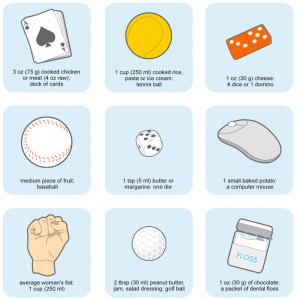 Per capita calorie intake has grown by 9 to 30 calories a day since the 1980s. Portion sizes have grown; as a result, so has the level of overweight and obesity in America. By 2020, 83% of men will be overweight or obese in the U.S.; so will 72% of U.S. women, according to Mark Huffman in a paper presented to the American Heart Association meeting in November 2011.
Per capita calorie intake has grown by 9 to 30 calories a day since the 1980s. Portion sizes have grown; as a result, so has the level of overweight and obesity in America. By 2020, 83% of men will be overweight or obese in the U.S.; so will 72% of U.S. women, according to Mark Huffman in a paper presented to the American Heart Association meeting in November 2011.
“An individual’s decision to eat is not a result of personal weakness, but rather is determined, to a great extent, by the many environmental cues that have emerged since the early 1980s as a consequence of the commercialization of food,” according to a study published in the journal, Public Health Nutrition.
Researchers at Cornell University found that exposure to food ads, portion size, fat content, the number of people eating, and location can all act as “food primes,’ driving people to eat more.
Health Populi’s Hot Points: To eat or not to eat? That is the question. But it’s not a simple one.
The Cornell researchers suggest that it’s society’s collective responsibility — read “government’s” — to shape the “food signals” in the environment that can bolster and support individuals’ responsibility to eat more healthfully.
This recommendation won’t go down easily with those U.S. citizens who balk at so-called Big Government, and individual mandates. Note that this month, the U.S. Supreme Court agreed to review the legitimacy of the individual health insurance mandate portion of the Affordable Care Act.
Beyond the issue of Nanny State, Big Government, and mandates — call this what you will — there’s another type of market failure when it comes to food in the form of food deserts. Many people don’t have access to fresh produce in their neighborhoods, which means their grocery baskets are filled with processed foods of less nutritional value.
Food is an integral component of health. Most people understand this; the Cornell study points to factors that compromise the self-control of individual consumers.




 I'm in amazing company here with other #digitalhealth innovators, thinkers and doers. Thank you to Cristian Cortez Fernandez and Zallud for this recognition; I'm grateful.
I'm in amazing company here with other #digitalhealth innovators, thinkers and doers. Thank you to Cristian Cortez Fernandez and Zallud for this recognition; I'm grateful. Jane was named as a member of the AHIP 2024 Advisory Board, joining some valued colleagues to prepare for the challenges and opportunities facing health plans, systems, and other industry stakeholders.
Jane was named as a member of the AHIP 2024 Advisory Board, joining some valued colleagues to prepare for the challenges and opportunities facing health plans, systems, and other industry stakeholders.  Join Jane at AHIP's annual meeting in Las Vegas: I'll be speaking, moderating a panel, and providing thought leadership on health consumers and bolstering equity, empowerment, and self-care.
Join Jane at AHIP's annual meeting in Las Vegas: I'll be speaking, moderating a panel, and providing thought leadership on health consumers and bolstering equity, empowerment, and self-care.